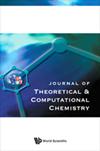Identification of therapeutic target in S2 domain of SARS nCov-2 Spike glycoprotein: Key to design and discover drug candidates for inhibition of viral entry into host cell
IF 2.4
Q3 Computer Science
Journal of Theoretical & Computational Chemistry
Pub Date : 2020-11-01
DOI:10.1142/s0219633620500285
引用次数: 4
Abstract
Humanity is facing a grieve danger of coronavirus disease-19 caused by severe acute respiratory syndrome novel coronavirus-2 (SARS nCov-2) There is an urgent need of therapeutics that can help in overcoming this global pandemic Identifying novel therapeutic target and screening already approved drug is a faster approach in this situation Spike glycoprotein (Sgp) of SARS nCoV-2 is potentials target where in researchers have targeted receptor binding domain (RBD) of S1 domain The S2 domain of Sgp also plays a pivotal role in viral entry, but the mechanism is less understood We analyzed the structure of Sgp S2 domain in pre-fusion state and Heptad repeat region in its post-fusion state available from protein data bank Sgp shows three major regions in S2 domain, the fusion peptide (FP), heptad repeat 1 (HR1) and central helical (CH) region The HR1 region undergoes structural changes by flipping approximately 180∘ and coil up to form a rod like structure during fusion process implying its role in viral entry into the host cell This structural change in S2 domain helices is crucial step, if this process is hindered by targeting the HR1 and CH region then the progression of virus can be stopped Possible binding cavity was identified near the HR1 and CH region in S2 domain and docking-based virtual screening of FDA approved drugs was performed Promising candidates like Troxerutin, Thymopentin and Daclatasvir can be used as therapeutics provided an immediate in-vitro and clinical studies are carried out by research groups Analysis of three-dimensional structure of SARS nCov-2 Spike glycoprotein (Sgp) S2 domain in pre-fusion and post-fusion sate indicate structural changes in S2 domain is vital for viral fusion and entry into host cell Most favorable drug binding site was identified in S2 domain and dock based virtual screening was carried out to obtain hit molecules from a database of already approved FDA drugs [ABSTRACT FROM AUTHOR] Copyright of Journal of Theoretical & Computational Chemistry is the property of World Scientific Publishing Company and its content may not be copied or emailed to multiple sites or posted to a listserv without the copyright holder's express written permission However, users may print, download, or email articles for individual use This abstract may be abridged No warranty is given about the accuracy of the copy Users should refer to the original published version of the material for the full abstract (Copyright applies to all Abstracts )SARS冠状病毒2型刺突糖蛋白S2结构域治疗靶点的鉴定:设计和发现抑制病毒进入宿主细胞的候选药物的关键
人类正面临严重急性呼吸综合征新冠病毒2型(SARS-nCov-2)引起的冠状病毒疾病19的悲痛危险。迫切需要有助于克服这一全球流行病的治疗方法。在这种情况下,识别新的治疗靶点并筛选已获批准的药物是一种更快的方法研究人员具有S1结构域靶向受体结合结构域(RBD)的靶点。Sgp的S2结构域在病毒进入中也起着关键作用,但其机制尚不清楚。我们从蛋白质数据库中分析了Sgp S2结构域融合前状态和Heptad重复区融合后状态的结构,七肽重复序列1(HR1)和中心螺旋(CH)区。HR1区在融合过程中通过翻转约180∘并卷曲形成杆状结构而发生结构变化,这意味着它在病毒进入宿主细胞中的作用。S2结构域螺旋的结构变化是关键的一步,如果靶向HR1和CH区域阻碍了这一过程,那么病毒的进展就可以停止。在S2结构域的HR1和CH区域附近发现了可能的结合腔,并对FDA批准的药物进行了基于对接的虚拟筛选,Thymemontin和Daclatasvir可作为治疗药物,只要能立即在体外进行,研究小组进行临床研究。对融合前和融合后的SARS-nCov-2刺突糖蛋白(Sgp)S2结构域的三维结构的分析表明,S2结构域中的结构变化对病毒融合和进入宿主细胞至关重要在S2结构域中鉴定,并进行了基于dock的虚拟筛选,以从已经批准的美国食品药品监督管理局药物数据库中获得命中分子[作者摘要]《理论与计算化学杂志》版权归世界科学出版公司所有,其内容在没有版权的情况下不得复制或通过电子邮件发送到多个网站或发布到listserv持有人的明确书面许可。但是,用户可以打印、下载或通过电子邮件发送文章供个人使用。本摘要可能会被删节。对副本的准确性不作任何保证。完整摘要用户应参考材料的原始出版版本(版权适用于所有摘要)
本文章由计算机程序翻译,如有差异,请以英文原文为准。
求助全文
约1分钟内获得全文
求助全文
来源期刊
CiteScore
1.70
自引率
0.00%
发文量
0
审稿时长
3 months
期刊介绍:
The Journal of Theoretical and Computational Chemistry (JTCC) is an international interdisciplinary journal aimed at providing comprehensive coverage on the latest developments and applications of research in the ever-expanding field of theoretical and computational chemistry.
JTCC publishes regular articles and reviews on new methodology, software, web server and database developments. The applications of existing theoretical and computational methods which produce significant new insights into important problems are also welcomed. Papers reporting joint computational and experimental investigations are encouraged. The journal will not consider manuscripts reporting straightforward calculations of the properties of molecules with existing software packages without addressing a significant scientific problem.
Areas covered by the journal include molecular dynamics, computer-aided molecular design, modeling effects of mutation on stability and dynamics of macromolecules, quantum mechanics, statistical mechanics and other related topics.

 求助内容:
求助内容: 应助结果提醒方式:
应助结果提醒方式:


